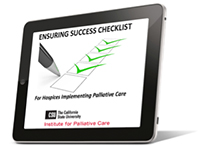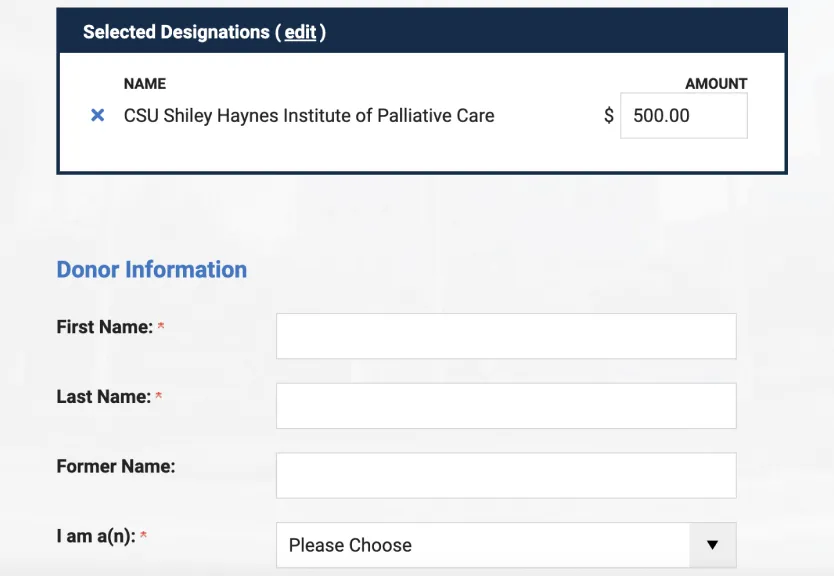A Message from Helen McNeal, Executive Director
Over the years, I’ve worked with numerous organizations building palliative care programs in the community and inpatient. The biggest predictor of the success of a program wasn’t the size or type of organization or the clinical skills of the team. The biggest predictor was whether or not the organization was committed to integrating palliative care, not simply implementing a program. If an organization is committed to deliberately working to integrate palliative care throughout the organization, that’s when the magic happens.
The Difference Between Implementing & Integrating a Palliative Care Program
Implementing your palliative care program is what so often happens in palliative care, and elsewhere. It’s about doing, which is good, if you have laid the foundation for what you’re doing to be understood and valued by all of the important audiences that need to know about it.
But doing by itself is not enough. What’s happened so often is that despite the potential for palliative care to transform care for all patients, many organizations use a prescription you will recognize to implement palliative care. They take one or two passionate and knowledgeable clinicians, borrow additional staff on an as-needed basis to be able to say that they have a team, send them off to get some clinical training on palliative care, and boom, they get started.
Then they expect from the rest of the organization the right referrals, and for other clinicians to understand what they are doing and why it is important. This rarely works out well, even with the most talented clinicians.
Learn more about our Community-Based Palliative Care courses.
Integrating is a Systemic Process
Integration is a systemic process that results in a palliative care program being understood and valued as an equal partner to the rest of the organization or community. The integration process starts before the program ever exists, happens over time, and continues over the life of the program. When a palliative care program is integrated into an organization, there is a sense of ownership of its success by those in the broader organization and, potentially, the community.
It is recognized and its role, who to refer to and how to refer, all is understood by everyone in that organization, and ultimately in the community it serves. This takes time, attention, and careful planning, but when this happens, not only do palliative care patients and their caregivers have access to and receive great care, all patients served by the organization receive better care.
In order to achieve your palliative care program’s clinical, quality, and physical goals, the implementation process must focus on integration from the very beginning.
Making Silos Disappear
When there is integration from day one, silos disappear because there is involvement and the resulting ownership of success across the organization is the reward. Department leaders respond to your requests, education of all staff about what palliative care is doing is a priority, and everyone recognizes that this isn’t just another project, it is an investment in person-centered care. It’s an investment in value-based healthcare.
With that in mind, here is a 20,000-foot overview of the five principles that lead to integration:
- Investment the Time – Organizations need to invest time and resources into the development and nurturing of the program.
- Engage the Partners – The planning and development process must be holistic. By that, I mean it needs to engage partners both within the organization, as well as external stakeholders who can champion it.
- Data-Based Planning – Create a plan that is based in data, not just hypotheses. Data that’s internal and external, and then refine the plan as needed based on feedback from allies and skeptics alike. And then, ensure the data that you are using is data that will make a strong case for what you want to do with your leadership and your stakeholders.
- Actionable Metrics – Invest in education, evaluation, and enhancement. Everyone in the organization needs an understanding of palliative care, from the people who answer the phones to the skilled team members who provide palliative care. You need to select and implement actionable metrics that are reasonable and feasible for you to collect.
- Recognize the Cultural Change – Recognize that creating a successful palliative care program is a culture change for most healthcare organizations, from a singular focus on cure, or in the case of hospices on a good death, to attending to quality of life and to patient’s needs and priorities for quality of life as well as for treatment.
This is a mindset shift, and when well done, it becomes part of the fabric and the culture of the organization.
My advice to you and my hope for your organization is that you spend time, you invest resources, and you involve more people in this process than you might have planned. But it’s definitely worth it, and in the long-term, the return will far outweigh the investment.
 If you are implementing a palliative care program, I hope you will use the Success Checklist to assess how you are doing on the path to success. And, I hope you will take time to visit our website and learn more about our palliative care tools and resources.
If you are implementing a palliative care program, I hope you will use the Success Checklist to assess how you are doing on the path to success. And, I hope you will take time to visit our website and learn more about our palliative care tools and resources.
At the Institute, our goal is to help you and your organization achieve that success in implementing community-based palliative care.
It’s our passion, it’s our mission, and we’re here to help you.




